"You're getting stuff the New York Times never will," Al Rockoff says, pointing to a series of framed images before him. "That's the truth."
The stuff is extraordinary: A single human hand being carried away by stretcher from the scene of a rocket attack.
The blackened, decomposing corpse of an AP photographer killed by Khmer Rouge troops.
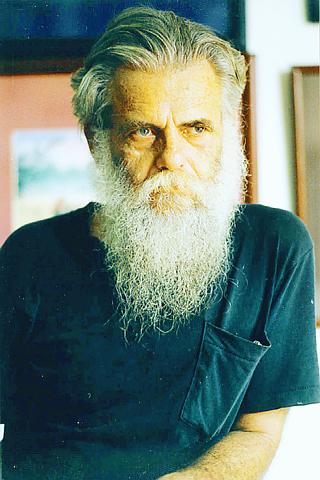
PHOTO: STEVEN O'CONNELL
A line of US Marines bracing against the wind kicked up by helicopter rotors during the American evacuation from Phnom Penh. For almost a decade, beginning as a US Army combat photographer in what he refers to as "the American war" in Vietnam followed by a stint as a freelance photographer from 1973-1975 capturing the brutal insanity of the Cambodian conflict and the eventual triumph of the Khmer Rouge, Rockoff gained a reputation for unforgettably macabre images he sold to Newsweek, AP, UPI, and the New York Times.
It was a brilliant career prematurely aborted by what he describes as a media "blacklist" against the use of his work following Rockoff's evacuation from the compound of Phnom Penh's French Embassy, along with the last remnants of the city's expatriate population, on May 7, 1975.
"I've been stiffed and ostracized," the bearded 52-year-old who was portrayed by the actor John Malkovich in Roland Joffe's film The Killing Fields says bitterly. "It's payback time."
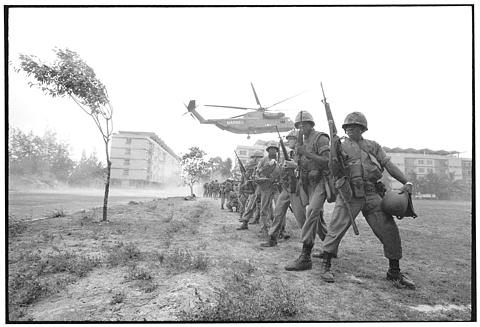
Payback, for Rockoff, is a special exhibition of his work in Phnom Penh to commemorate the 25th anniversary of the fall of the city to the Khmer Rouge on April 17, 1975.
It's an exhibition that Rockoff, out of all the photojournalists who covered the Indochinese conflict, is uniquely qualified to give.
"I shed blood for my art," he says of his passion for combat photography that led him to be wounded nine times and left him with the same unsettling thousand yard stare discernible in many of his subjects.
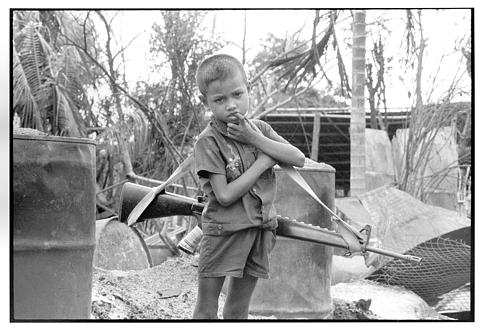
But it was Rockoff's coverage of the fall of Phnom Penh that was the pinnacle of a career he describes as "creative endeavor with an adrenaline rush."
As the Khmer Rouge entered Phnom Penh on April 17, 1975, beginning the systematic murder of military and government officials of the defeated Lon Nol regime and the evacuation of the general population to the Cambodian countryside, Rockoff roamed the city snapping incomparable photos of a society in its death throes.
"When the Khmer Rouge entered Phnom Penh people lined up along the sides of the street waving, while loudspeakers announced `the war is over , do not resist,'" he recalled.
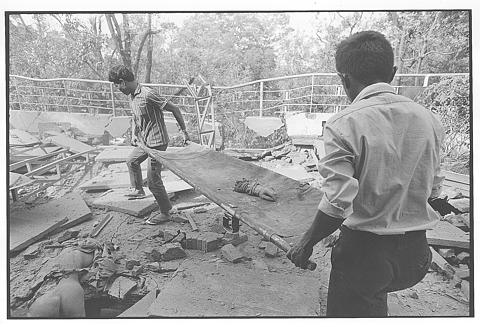
"People though the worst was over ... little did they know it had just begun."
Rockoff had an eerie first hint of the harsh reality of Cambodia's new order later that afternoon, when along with New York Times correspondent Sidney Schanberg and Cambodian interpreter Dith Pran he was detained by Khmer Rouge troops on the Japanese Bridge in central Phnom Penh.
"A Khmer Rouge soldier opened up Schanberg's travel bag and found his US$10,000 of `emergency money' and some underwear," he explained. "The soldier fanned through all the notes carefully, then took the underwear, leaving the money in the bag for Schan-berg."
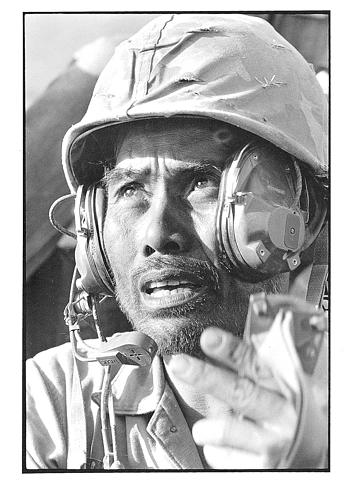
The symbolism of the soldier's disdain for money did not escape Rockoff -- in the pure, hard flame of the Khmer Rouge revolution, money was a fetish of the old society that was coming to an end. Rockoff becomes visibly angry at the mention of Schanberg, whom he accuses of deliberately and maliciously sabotaging his career.
"Schanberg left on the first convoy out of the French Embassy and asked me for the rolls of film that I'd shot," Rockoff said heatedly.
"When I told him that I was on day rate for Newsweek and that he could only have the pictures they didn't want he said `See if the New York Times ever runs any of your stuff again.'"
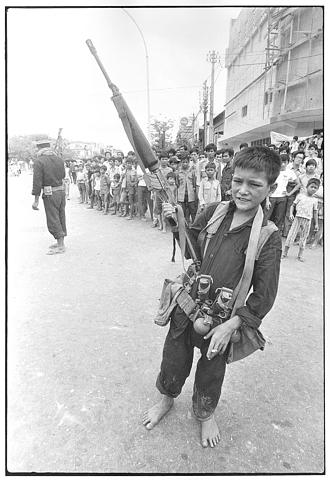
In the end Newsweek only ran three of Rockoff's photos, and upon his return to the US he was relegated to the journalistic margins, the vast majority of his work unseen.
Insult was added to injury following the release of the movie The Killing Fields, which Rockoff insists is full of "slanderous" misrepresentations of the historical record.
Rockoff remains incensed by the movie's representation of Schanberg as a concerned, sensitive individual who agonized over the fate of his Cambodian interpreter, Dith Pran.
"Schanberg is a coward who put other people's lives in danger," Rockoff barked angrily. "He used and abused Dith Pran and personally tried to have me thrown out of the safety of the French Embassy in April 1975."
Rockoff is most aggrieved at one of the scenes most emotional moments: when a photograph that Malkovich as Rockoff has taken of Dith Pran for a false passport is spoiled by a chemical reaction.
According to Rockoff and others who were present, the scene is completely fictional.
"It never happened," Rockoff said. "That movie blames and slanders me."
Through his exhibition and a planned book of photographs documenting the Cambodian conflict and its post-Khmer Rouge reconstruction, Rockoff hopes to correct what he feels are equally serious public misconceptions about the destruction of Cambodia he chronicled in the 1970s.
"A lot of people don't even remember what the war [in Cambodia] was all about, and specifically the role of the [1970] American invasion in what eventually happened here," he said grimly. "The blood debt that America owes Cambodia is a big one."

Auckland rang in 2026 with a downtown fireworks display launched from New Zealand’s tallest structure, Sky Tower, making it the first major city to greet the new year at a celebration dampened by rain, while crowds in Taipei braved the elements to watch Taipei 101’s display. South Pacific countries are the first to bid farewell to 2025. Clocks struck midnight in Auckland, with a population of 1.7 million, 18 hours before the famous ball was to drop in New York’s Times Square. The five-minute display involved 3,500 fireworks launched from the 240m Sky Tower. Smaller community events were canceled across New Zealand’s

The Ministry of Foreign Affairs (MOFA) yesterday said it is closely monitoring developments in Venezuela, and would continue to cooperate with democratic allies and work together for regional and global security, stability, and prosperity. The remarks came after the US on Saturday launched a series of airstrikes in Venezuela and kidnapped Venezuelan President Nicolas Maduro, who was later flown to New York along with his wife. The pair face US charges related to drug trafficking and alleged cooperation with gangs designated as terrorist organizations. Maduro has denied the allegations. The ministry said that it is closely monitoring the political and economic situation
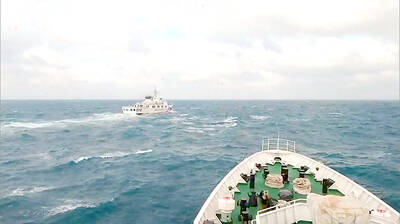
‘SLICING METHOD’: In the event of a blockade, the China Coast Guard would intercept Taiwanese ships while its navy would seek to deter foreign intervention China’s military drills around Taiwan this week signaled potential strategies to cut the nation off from energy supplies and foreign military assistance, a US think tank report said. The Chinese People’s Liberation Army (PLA) conducted what it called “Justice Mission 2025” exercises from Monday to Tuesday in five maritime zones and airspace around Taiwan, calling them a warning to “Taiwanese independence” forces. In a report released on Wednesday, the Institute for the Study of War said the exercises effectively simulated blocking shipping routes to major port cities, including Kaohsiung, Keelung and Hualien. Taiwan would be highly vulnerable under such a blockade, because it

UNRELENTING: China attempted cyberattacks on Taiwan’s critical infrastructure 2.63 million times per day last year, up from 1.23 million in 2023, the NSB said China’s cyberarmy has long engaged in cyberattacks against Taiwan’s critical infrastructure, employing diverse and evolving tactics, the National Security Bureau (NSB) said yesterday, adding that cyberattacks on critical energy infrastructure last year increased 10-fold compared with the previous year. The NSB yesterday released a report titled Analysis on China’s Cyber Threats to Taiwan’s Critical Infrastructure in 2025, outlining the number of cyberattacks, major tactics and hacker groups. Taiwan’s national intelligence community identified a large number of cybersecurity incidents last year, the bureau said in a statement. China’s cyberarmy last year launched an average of 2.63 million intrusion attempts per day targeting Taiwan’s critical